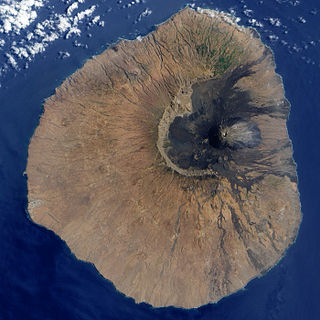
The International Union for Conservation of Nature (IUCN) Red List of Threatened Species, founded in 1964, is the world's most comprehensive inventory of the global conservation status of biological species. It uses a set of criteria to evaluate the extinction risk of thousands of species and subspecies. These criteria are relevant to all species and all regions of the world. With its strong scientific base, the IUCN Red List is recognized as the most authoritative guide to the status of biological diversity. A series of Regional Red Lists are produced by countries or organizations, which assess the risk of extinction to species within a political management unit.

Fogo is an island in the Sotavento group of Cape Verde. Its population is 35,837 (2015), with an area of 476 km2. It reaches the highest altitude of all the islands in Cape Verde, rising to 2,829 metres above sea level at the summit of its active volcano, Pico do Fogo.

Hydnocarpus is a genus of medium to large trees in the Family Achariaceae; the genus was previously placed in the now defunct family Flacourtiaceae. Species have been recorded from Indochina, Indonesia, Malaysia and the Philippines.

A genet is a member of the genus Genetta, which consists of 14 to 17 species of small African carnivorans. The common genet is the only genet present in Europe and occurs in the Iberian Peninsula and France.
This article is a list of biological species, subspecies, and evolutionary significant units that are known to have become extinct during the Holocene, the current geologic epoch, ordered by their known or approximate date of disappearance from oldest to most recent.

Carpoxylon macrospermum is a species of palm tree endemic to Vanuatu, and the only species in the genus Carpoxylon.
Hydnocarpus cucurbitinus is a species of plant in the Achariaceae family. It is a tree endemic to Peninsular Malaysia. It is threatened by habitat loss.
Hydnocarpus hainanensis is a species of plant in the Achariaceae family. It is found in China and Vietnam. It is threatened by habitat loss.
Hydnocarpus humei is a species of plant in the family Achariaceae. It is a tree endemic to Peninsular Malaysia. It is threatened by habitat loss.

Hydnocarpus kurzii is a species of plant in the family Achariaceae. It is found in India and Myanmar.
Hydnocarpus nanus is a species of plant in the family Achariaceae. It is a tree endemic to Peninsular Malaysia. It is threatened by habitat loss.
Hydnocarpus octandrus is a species of plant in the Achariaceae family, but originally placed in the Flacourtiaceae family by Arthur Cronquist. It is endemic to Sri Lanka.
Hydnocarpus scortechinii is a species of plant in the family Achariaceae. It is a tree endemic to Peninsular Malaysia. It is threatened by habitat loss.

Leucadendron discolor is a species of plant in the family Proteaceae. It is endemic to South Africa. It is threatened by habitat loss. In English the plant is known as the Piketberg Conebush and in Afrikaans as the Rooitolbos. L. discolor is a slow growing perennial. Growth of the root system and propagation, from a seed to the plant's first flower, can take up to two years. The male L. discolor 'Sunset' flowers exuberantly during early spring exposing a colorful flowerhead during this time.The flower head is composed of a dome-like receptacle, and is densely covered with small male flowers. These plants are only able to reproduce after their third year of life.
Myristica filipes is a species of plant in the family Myristicaceae. It is endemic to Papua New Guinea.
Pimenta filipes is a species of plant in the family Myrtaceae. It is endemic to Cuba.

Hydnocarpus annamensis is a tree in the Achariaceae family. It is found in Thailand, Cambodia, Vietnam, southern Yunnan and southern Guangxi in Zhōngguó/China. It is threatened by habitat loss. The plant produces low-quality wood and its fruit are used in traditional medicine.

Fogo Natural Park, on the island of Fogo, is one of ten "natural parks" in the country of Cape Verde. The protected area is 84.69 km2 (32.70 sq mi), which is 17.8% of the total area of the island. 50% of the park lies within the municipality Santa Catarina do Fogo, 28% in municipality of Mosteiros and 22% in São Filipe. The natural park is situated in the interior of the island, and covers the volcano Pico do Fogo, its crater and crater rim (Bordeira) and the forest of Monte Velha. The volcano is active; the most recent eruption was in 2014-15.









